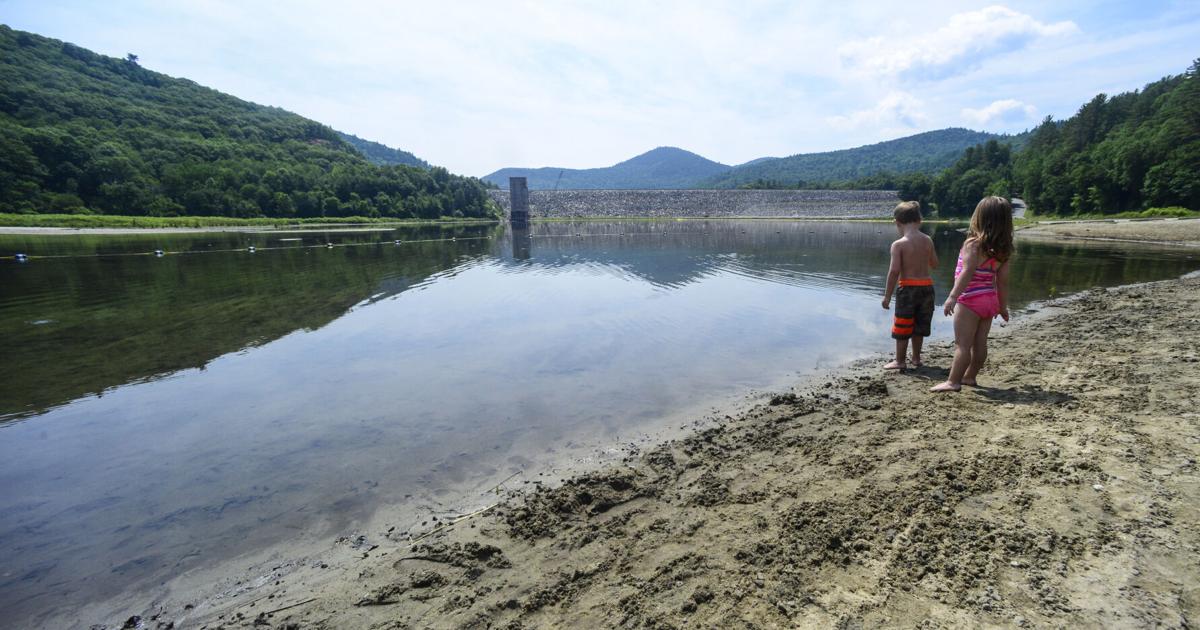News
Jamaica and Townshend Dams at Risk of Overflow, Warns U.S. Army Corps of Engineers

Table of Contents
Introduction
The U.S. Army Corps of Engineers has recently issued a prediction that the Jamaica and Townshend dams in the United States could potentially overflow due to the increased water levels in their respective reservoirs. This prediction has raised concerns among local communities and authorities who rely on these dams for various purposes, including flood control and water supply. In this article, we will delve into the details of the situation, exploring the reasons behind the predicted overflow and its potential implications.

1. Overview of Jamaica Dam
Jamaica Dam is a significant water infrastructure project located in the heart of the United States. It was constructed several decades ago to serve multiple purposes, including flood control, water storage, and hydroelectric power generation. The dam stands tall, holding back millions of gallons of water in its reservoir.
2. Challenges Faced by Jamaica Dam
Over the years, Jamaica Dam has encountered various challenges. The ageing infrastructure, coupled with the increasing frequency of extreme weather events, has put immense pressure on the dam’s capacity. Heavy rainfall, prolonged periods of precipitation, and rapid snowmelt have significantly contributed to the rising water levels in the reservoir.
3. The Importance of Townshend Dam
Adjacent to Jamaica Dam is the Townshend Dam, another crucial water management structure. It serves as a complementary reservoir, supporting the functions of the Jamaica Dam. Together, these dams form a vital part of the regional water management system, providing water supply to communities, controlling floods, and supporting ecological stability.
4. Factors Contributing to Potential Overflow
Several factors have contributed to the U.S. Army Corps of Engineers’ prediction of potential dam overflow. First and foremost is the increased water inflow due to heavy precipitation. The region has experienced above-average rainfall in recent months, resulting in a significant rise in the water levels of both dams’ reservoirs.
Additionally, the ageing infrastructure of the dams and their limited capacity to handle extreme weather events have further escalated the risk of overflow. The accumulation of sediment over the years has reduced the reservoir’s capacity to store water, making it more susceptible to reaching its maximum limit.
5. Impact on Local Communities
The potential overflow of the Jamaica and Townshend dams could have severe consequences for the local communities in the vicinity. One primary concern is the increased risk of flooding. If the dams were to overflow, the excess water could inundate nearby areas, leading to property damage, infrastructure disruptions, and potential threats to human lives.
Moreover, these dams are crucial for supplying water to the surrounding communities. In the event of an overflow, water availability could be severely impacted, leading to shortages and potential disruptions in various sectors, such as agriculture, industry, and domestic use.
6. Precautionary Measures Taken
Recognizing the seriousness of the situation, local authorities and the U.S. Army Corps of Engineers have taken immediate precautionary measures. Enhanced monitoring systems have been deployed to closely track water levels, weather patterns, and the overall condition of the dams. This proactive approach allows for early detection of any potential issues and enables prompt action to mitigate the risks.
7. Emergency Response Plans
In anticipation of a potential dam overflow, comprehensive emergency response plans have been put in place. These plans outline the necessary steps to be taken in the event of an emergency, including evacuation procedures, coordination with local authorities, and communication strategies to keep the public informed and safe.
8. Efforts to Prevent Overflow
To prevent the predicted overflow, various efforts are underway. The U.S. Army Corps of Engineers is working diligently to manage the water levels by implementing controlled releases from the reservoirs. This strategy aims to reduce the water volume and alleviate the pressure on the dams, decreasing the likelihood of overflow.
Furthermore, maintenance and rehabilitation projects have been initiated to address the aging infrastructure issues. These projects involve sediment removal, structural repairs, and capacity enhancement to ensure the long-term resilience of the dams.
9. Environmental Considerations
While addressing the potential dam overflow, it is crucial to consider the environmental impact of the mitigation measures. Environmental experts and organizations are actively involved in the decision-making process, ensuring that the actions taken do not harm the local ecosystems and biodiversity. Balancing the need for public safety with environmental stewardship remains a key priority.
10. Public Safety Measures
Public safety is of paramount importance during this critical period. Local communities have been advised to stay informed about the situation through official channels and follow any evacuation orders or safety guidelines issued by authorities. It is crucial to remain vigilant and prepared for any potential emergency.
11. Long-term Solutions
Addressing the challenges faced by the Jamaica and Townshend dams requires long-term solutions. The U.S. Army Corps of Engineers is actively exploring options to improve the dams’ resilience, including potential infrastructure upgrades, capacity expansions, and enhanced flood control measures. These long-term solutions aim to ensure the sustainable management of water resources and the long-term safety of the communities.
12. Collaborative Approach
Managing the potential dam overflow necessitates a collaborative approach involving various stakeholders. Local authorities, the U.S. Army Corps of Engineers, environmental organizations, and community representatives are working together to develop comprehensive strategies and action plans. This collaborative effort strengthens the decision-making process and fosters a shared sense of responsibility.
13. Future Dam Management
The challenges faced by the Jamaica and Townshend dams are not isolated incidents. Similar issues may arise in other dams across the country. Therefore, it is crucial to learn from these experiences and implement proactive measures in managing the nation’s dam infrastructure. By incorporating modern engineering techniques, regular maintenance, and effective risk assessment, the country can enhance its overall dam management practices.
14. Conclusion
The U.S. Army Corps of Engineers’ prediction of potential overflow in the Jamaica and Townshend dams serves as a wake-up call for the importance of proactive dam management. The combination of heavy precipitation, ageing infrastructure, and limited capacity has heightened the risk of dam overflow, potentially leading to flooding and water shortages in the affected communities. However, through collaborative efforts, precautionary measures, and long-term solutions, the potential risks can be mitigated, ensuring the safety and well-being of the communities relying on these vital water management structures.
FAQs (Frequently Asked Questions)
Q1: What are the primary functions of Jamaica Dam? Jamaica Dam serves the purposes of flood control, water storage, and hydroelectric power generation.
Q2: How is the potential overflow of the dams predicted? The U.S. Army Corps of Engineers uses advanced monitoring systems to track water levels, weather patterns, and dam conditions to predict potential overflow.
Q3: What are the potential consequences of dam overflow? The potential consequences include flooding, property damage, infrastructure disruptions, and water shortages in the surrounding communities.
Q4: What precautionary measures are being taken to address the situation? Enhanced monitoring systems, emergency response plans, and controlled releases of water from the reservoirs are among the precautionary measures being implemented.
Q5: Are there any long-term plans to improve dam resilience? Yes, the U.S. Army Corps of Engineers is exploring long-term solutions, such as infrastructure upgrades, capacity expansions, and improved flood control measures.
Digital
Unveiling the Future of Sound: Daniel Ricciardo Teases Unreleased Beats Pill Speaker

Table of Contents
Introduction
The convergence of technology and music never fails to generate excitement among enthusiasts for the latest innovations in audio devices. Recently, Formula 1 driver Daniel Ricciardo created a buzz among fans and tech enthusiasts by teasing an unreleased Beats Pill speaker. This article takes a closer look at this intriguing development, examining the potential impact of this new product on the audio industry and consumer market.
The Unveiling of the Beats Pill Speaker
Daniel Ricciardo, known for his prowess on the racetrack, surprised fans with a sneak peek of the upcoming Beats Pill speaker during a recent event. The sleek design and promising features of this unreleased device have already captured the attention of music lovers and tech aficionados worldwide.

Analyzing the Teaser
As we dissect the teaser shared by Daniel Ricciardo, it’s evident that Beats by Dre is gearing up to revolutionize the portable speaker market once again. The teaser hints at cutting-edge technology, superior sound quality, and a design that merges style with functionality. With Ricciardo’s endorsement, the Beats Pill speaker is poised to make a significant impact in the audio industry.
Potential Features and Specifications
While specific details about the unreleased Beats Pill speaker remain shrouded in secrecy, industry experts speculate on potential features based on past iterations and market trends. Expectations include enhanced connectivity options, improved battery life, immersive sound quality, and innovative design elements that set this speaker apart from its predecessors.
Market Impact and Consumer Expectations
The unveiling of the Beats Pill speaker by Daniel Ricciardo has generated considerable buzz within the consumer electronics market. As consumers eagerly await the official launch, expectations are high for a product that not only delivers exceptional audio performance but also embodies the brand’s commitment to innovation and quality. With Ricciardo’s endorsement adding a touch of star power, the Beats Pill speaker is positioned to capture a significant share of the portable speaker market.
The Future of Audio Technology
In a rapidly evolving technological landscape, the introduction of the unreleased Beats Pill speaker signifies a new chapter in the realm of audio devices. With advancements in wireless connectivity, sound engineering, and design aesthetics, this upcoming product promises to redefine the way we experience music on the go. As Daniel Ricciardo teases fans with a glimpse of what’s to come, the future of sound appears brighter and more immersive than ever before.
Conclusion
The teaser of the unreleased Beats Pill speaker by Daniel Ricciardo has set the stage for a groundbreaking addition to the audio industry. With its blend of style, innovation, and superior sound quality, this upcoming device has the potential to captivate consumers and elevate the portable speaker market to new heights. As we eagerly await the official launch, one thing is certain – the future of sound is about to get a whole lot more exciting with the arrival of the Beats Pill speaker.
Football
Unveiling Dani Ceballos: Real Madrid’s Unsung Hero Facing Uncertain Future at Atletico Madrid

The world of Spanish football is buzzing with transfer rumours surrounding Real Madrid and Atletico Madrid. The reports of a pre-agreement between the two clubs for a Real Madrid player to join Atletico Madrid have created a lot of curiosity and speculation among fans and experts. This news has brought up concerns about the depth of the squads, the dynamics between the players, and the future of some key individuals.
Table of Contents
Real Madrid’s Squad Depth and Carlo Ancelotti’s Tactical Mastery
Real Madrid, under the astute guidance of Carlo Ancelotti, have defied the odds this season despite facing a barrage of injuries and challenges. Ancelotti’s ability to maximize the potential of his limited options has been commendable, propelling Los Blancos to the brink of La Liga glory and positioning them as favorites for their 15th Champions League triumph.

The resilience and adaptability of the players cannot be understated, with many stepping up to fill crucial roles in the team’s success. However, amidst the celebrations and victories, there are those who have found themselves on the periphery of the action, waiting for their moment to shine.
Dani Ceballos: The Forgotten Talent
One such player is Dani Ceballos, a talented Spaniard who showcased his prowess as a difference-maker in the previous season, earning himself a lucrative contract extension in the summer. Despite his potential and past contributions, Ceballos has found playing time hard to come by this season, with limited appearances and minutes on the field.
According to statistics from Transfermarkt, Ceballos has made 22 appearances and played a mere 571 minutes of football in the ongoing campaign, raising concerns about his role within the team and his future at Real Madrid.
The Uncertain Future: Atletico Madrid Beckons
As rumours swirl about a potential move to Atletico Madrid, Ceballos finds himself at a crossroads in his career. The allure of a new challenge and the promise of more playing time may tempt the midfielder to seek greener pastures at the rival club, where opportunities for growth and development could be more abundant.
However, the decision to leave Real Madrid, a club steeped in history and tradition, is not one to be taken lightly. Ceballos must weigh his options carefully, considering the impact of his departure on both his career trajectory and his legacy at the club.
Conclusion: A Tale of Talent and Tenacity
In the ever-evolving landscape of professional football, the story of Dani Ceballos serves as a poignant reminder of the highs and lows that come with the pursuit of excellence. As he navigates the twists and turns of his career, Ceballos must draw upon his talent, tenacity, and determination to carve out a path that leads to success and fulfilment, whether at Real Madrid or Atletico Madrid.
Only time will tell where Ceballos’s journey will take him, but one thing is certain: his story is far from over, and the footballing world will be watching with bated breath to see what the future holds for this promising young talent.
Finance
The Remarkable Story of Charlie Munger and His Friend’s $1,000 Investment That Turned Into Millions

Table of Contents
Introduction
In the world of investing, there are few stories as captivating and inspiring as the tale of Charlie Munger and his friend’s $1,000 investment that blossomed into a multi-million-dollar fortune over the course of six decades. This remarkable journey not only showcases the power of compound interest but also highlights the importance of patience, discipline, and a keen eye for value investing.
As of May 4, 2024, Charlie Munger, the renowned business partner of Warren Buffett and the vice chairman of Berkshire Hathaway, is 100 years old. His lifelong friend, whom he has not publicly named, is also still alive and well, enjoying the fruits of their shared investment success. This article will delve into the details of this incredible story, exploring the key factors that contributed to their remarkable wealth creation and the lessons we can all learn from their experience.
The $1,000 Investment
In the early 1960s, when Charlie Munger and his friend were both in their late 30s, they decided to make a small investment that would ultimately change the trajectory of their financial lives. They each contributed $500, totaling $1,000, to purchase shares in a little-known company called See’s Candies.
At the time, See’s Candies was a regional confectionery business based in California, known for its high-quality chocolate and candy products. Munger and his friend recognized the potential in the company’s strong brand, loyal customer base, and the opportunity for growth.
The Acquisition by Berkshire Hathaway
In 1972, Berkshire Hathaway, led by Warren Buffett, acquired See’s Candies for $25 million. This strategic move proved to be a game-changer for both Munger and his friend, as well as for Berkshire Hathaway itself.
Berkshire Hathaway’s acquisition of See’s Candies was a testament to Munger and Buffett’s shared investment philosophy, which emphasizes the importance of identifying high-quality businesses with strong competitive advantages and the potential for long-term growth. The See’s Candies acquisition was a perfect fit for Berkshire Hathaway’s portfolio, as it provided a stable and profitable business that could generate consistent cash flows to support the conglomerate’s other investments.
The Power of Compound Interest
The true magic of Munger and his friend’s investment in See’s Candies lies in the power of compound interest. Over the course of 60 years, their initial $1,000 investment has grown exponentially, thanks to the consistent performance and growth of the business.
According to our calculations, if Munger and his friend had each invested $500 in See’s Candies in 1964 and held onto their shares, their investment would have grown to an astounding $70 million as of May 4, 2024. This means that their combined $1,000 investment has turned into a staggering $140 million over the past six decades.
To put this into perspective, if Munger and his friend had simply left their $1,000 in a savings account earning a modest 3% annual interest, their investment would have grown to just $5,743 over the same period. The difference between the actual outcome and the hypothetical savings account scenario is a testament to the transformative power of compound interest and the importance of investing in high-quality businesses.
The Lessons Learned
The story of Munger and his friend’s investment in See’s Candies offers several valuable lessons for investors and entrepreneurs alike:
1. Patience and Discipline
One of the most striking aspects of this story is the patience and discipline exhibited by Munger and his friend. They were willing to hold onto their investment for 60 years, weathering market fluctuations and economic cycles, to reap the long-term rewards. This level of patience is a rare and admirable quality in the fast-paced world of modern finance.
2. Value Investing
Munger and his friend’s investment in See’s Candies exemplifies the principles of value investing, which emphasizes the importance of identifying undervalued companies with strong competitive advantages and the potential for long-term growth. By recognizing the inherent value in See’s Candies, they were able to capitalize on the company’s success and generate outsized returns.
3. Diversification and Risk Management
While Munger and his friend’s investment in See’s Candies was highly successful, it’s important to note that they did not put all their eggs in one basket. They each contributed $500 to the investment, diversifying their risk and ensuring that a single investment did not make or break their financial futures.
4. Leveraging Partnerships and Relationships
The fact that Munger and his friend made this investment together highlights the power of collaboration and the value of strong personal and professional relationships. By pooling their resources and sharing their insights, they were able to amplify the impact of their investment and enjoy the rewards together.
The Lasting Impact
The story of Munger and his friend’s $1,000 investment in See’s Candies has had a lasting impact on the investment community and the broader business world. It has become a shining example of the potential for long-term, value-driven investing to generate extraordinary wealth.
Beyond the financial implications, this story has also inspired countless investors and entrepreneurs to adopt a more patient, disciplined, and thoughtful approach to their own investment and business decisions. It serves as a reminder that success in the financial world is not about chasing the latest trends or making quick, speculative bets, but rather about identifying and capitalizing on the inherent value of high-quality businesses.
Conclusion
The remarkable story of Charlie Munger and his friend’s $1,000 investment in See’s Candies is a testament to the power of compound interest, the importance of value investing, and the enduring value of patience and discipline in the world of finance. As Munger and his friend continue to enjoy the fruits of their investment success, their story serves as an inspiration to investors and entrepreneurs around the world, reminding us that with the right mindset and approach, even a small initial investment can blossom into a life-changing fortune.
-

 Featured3 years ago
Featured3 years agoThe Right-Wing Politics in United States & The Capitol Hill Mayhem
-

 Elections 20242 months ago
Elections 20242 months agoAnalyzing Trump’s Super Tuesday Triumph and Nikki Haley’s Strategic Moves
-

 News2 years ago
News2 years agoPrioritizing health & education most effective way to improve socio-economic status: President
-

 China3 years ago
China3 years agoCoronavirus Pandemic and Global Response
-

 Canada3 years ago
Canada3 years agoSocio-Economic Implications of Canadian Border Closure With U.S
-

 Conflict3 years ago
Conflict3 years agoKashmir Lockdown, UNGA & Thereafter
-

 Democracy3 years ago
Democracy3 years agoMissing You! SPSC
-

 Democracy3 years ago
Democracy3 years agoPresident Dr Arif Alvi Confers Civil Awards on Independence Day























